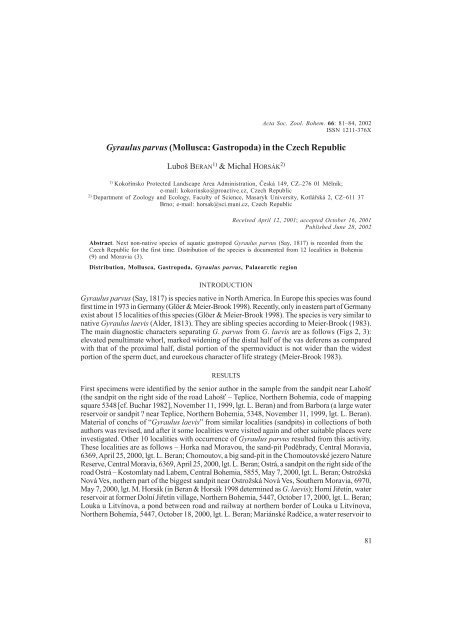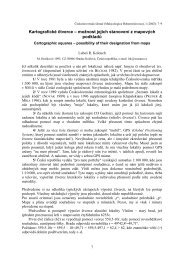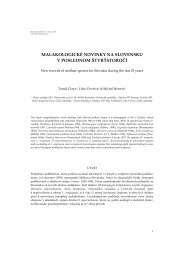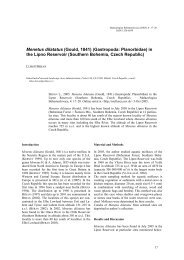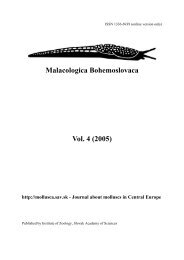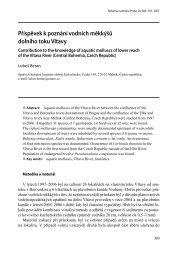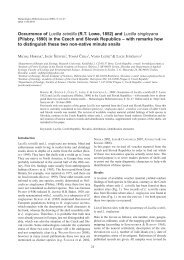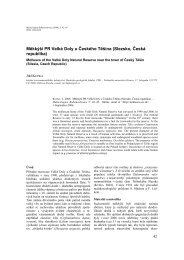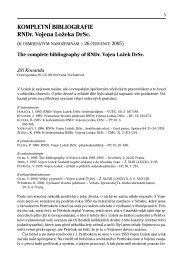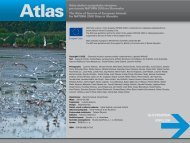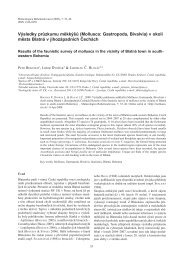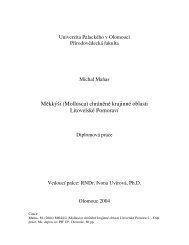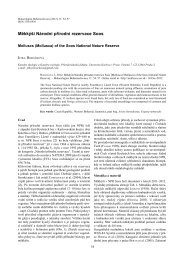Gyraulus parvus (Mollusca: Gastropoda) in the Czech Republic
Gyraulus parvus (Mollusca: Gastropoda) in the Czech Republic
Gyraulus parvus (Mollusca: Gastropoda) in the Czech Republic
- No tags were found...
You also want an ePaper? Increase the reach of your titles
YUMPU automatically turns print PDFs into web optimized ePapers that Google loves.
Acta Soc. Zool. Bohem. 66: 81–84, 2002ISSN 1211-376X<strong>Gyraulus</strong> <strong>parvus</strong> (<strong>Mollusca</strong>: <strong>Gastropoda</strong>) <strong>in</strong> <strong>the</strong> <strong>Czech</strong> <strong>Republic</strong>Luboš BERAN 1) & Michal HORSÁK 2)1)Kokoínsko Protected Landscape Area Adm<strong>in</strong>istration, eská 149, CZ–276 01 Mlník;e-mail: kokor<strong>in</strong>sko@proactive.cz, <strong>Czech</strong> <strong>Republic</strong>2)Department of Zoology and Ecology, Faculty of Science, Masaryk University, Kotláská 2, CZ–611 37Brno; e-mail: horsak@sci.muni.cz, <strong>Czech</strong> <strong>Republic</strong>Received April 12, 2001; accepted October 16, 2001Published June 28, 2002Abstract. Next non-native species of aquatic gastropod <strong>Gyraulus</strong> <strong>parvus</strong> (Say, 1817) is recorded from <strong>the</strong><strong>Czech</strong> <strong>Republic</strong> for <strong>the</strong> first time. Distribution of <strong>the</strong> species is documented from 12 localities <strong>in</strong> Bohemia(9) and Moravia (3).Distribution, <strong>Mollusca</strong>, <strong>Gastropoda</strong>, <strong>Gyraulus</strong> <strong>parvus</strong>, Palaearctic regionINTRODUCTION<strong>Gyraulus</strong> <strong>parvus</strong> (Say, 1817) is species native <strong>in</strong> North America. In Europe this species was foundfirst time <strong>in</strong> 1973 <strong>in</strong> Germany (Glöer & Meier-Brook 1998). Recently, only <strong>in</strong> eastern part of Germanyexist about 15 localities of this species (Glöer & Meier-Brook 1998). The species is very similar tonative <strong>Gyraulus</strong> laevis (Alder, 1813). They are sibl<strong>in</strong>g species accord<strong>in</strong>g to Meier-Brook (1983).The ma<strong>in</strong> diagnostic characters separat<strong>in</strong>g G. <strong>parvus</strong> from G. laevis are as follows (Figs 2, 3):elevated penultimate whorl, marked widen<strong>in</strong>g of <strong>the</strong> distal half of <strong>the</strong> vas deferens as comparedwith that of <strong>the</strong> proximal half, distal portion of <strong>the</strong> spermoviduct is not wider than <strong>the</strong> widestportion of <strong>the</strong> sperm duct, and euroekous character of life strategy (Meier-Brook 1983).RESULTSFirst specimens were identified by <strong>the</strong> senior author <strong>in</strong> <strong>the</strong> sample from <strong>the</strong> sandpit near Lahoš(<strong>the</strong> sandpit on <strong>the</strong> right side of <strong>the</strong> road Lahoš – Teplice, Nor<strong>the</strong>rn Bohemia, code of mapp<strong>in</strong>gsquare 5348[cf. Buchar 1982], November 11, 1999, lgt. L. Beran) and from Barbora (a large waterreservoir or sandpit ? near Teplice, Nor<strong>the</strong>rn Bohemia, 5348, November 11, 1999, lgt. L. Beran).Material of conchs of “<strong>Gyraulus</strong> laevis” from similar localities (sandpits) <strong>in</strong> collections of bothauthors was revised, and after it some localities were visited aga<strong>in</strong> and o<strong>the</strong>r suitable places were<strong>in</strong>vestigated. O<strong>the</strong>r 10 localities with occurrence of <strong>Gyraulus</strong> <strong>parvus</strong> resulted from this activity.These localities are as follows – Horka nad Moravou, <strong>the</strong> sand-pit Podbrady, Central Moravia,6369, April 25, 2000, lgt. L. Beran; Chomoutov, a big sand-pit <strong>in</strong> <strong>the</strong> Chomoutovské jezero NatureReserve, Central Moravia, 6369, April 25, 2000, lgt. L. Beran; Ostrá, a sandpit on <strong>the</strong> right side of <strong>the</strong>road Ostrá – Kostomlaty nad Labem, Central Bohemia, 5855, May 7, 2000, lgt. L. Beran; OstrožskáNová Ves, no<strong>the</strong>rn part of <strong>the</strong> biggest sandpit near Ostrožská Nová Ves, Sou<strong>the</strong>rn Moravia, 6970,May 7, 2000, lgt. M. Horsák (<strong>in</strong> Beran & Horsák 1998 determ<strong>in</strong>ed as G. laevis); Horní Jietín, waterreservoir at former Dolní Jietín village, Nor<strong>the</strong>rn Bohemia, 5447, October 17, 2000, lgt. L. Beran;Louka u Litvínova, a pond between road and railway at nor<strong>the</strong>rn border of Louka u Litvínova,Nor<strong>the</strong>rn Bohemia, 5447, October 18, 2000, lgt. L. Beran; Mariánské Radice, a water reservoir to81
Fig. 1. Map of <strong>the</strong> <strong>Czech</strong> <strong>Republic</strong> with mapp<strong>in</strong>g squares of known distribution of <strong>Gyraulus</strong> <strong>parvus</strong> (Say).Fig. 2. A conch of <strong>Gyraulus</strong> <strong>parvus</strong> (Say), Ostrožská Nová Ves, 30×, 4.9×1.6 mm. Photo M. Horsák.82
Fig. 3. <strong>Gyraulus</strong> <strong>parvus</strong> (Say), mrp – penis retractor muscle, prp – preaputium, psh – penis sheat, dh – distal halfof vas deferens, ph – proximal half of vas deferens, ut – uterus. Scale = 1 mm. Orig. M. Horsák.<strong>the</strong> south from Mariánské Radice, Nor<strong>the</strong>rn Bohemia, 5447, October 18, 2000, lgt. L. Beran; MariánskéRadice, a small pond at left side of <strong>the</strong> road Mariánské Radice – Braany to <strong>the</strong> east fromMariánské Radice, Nor<strong>the</strong>rn Bohemia, 5448, October, 18, 2000, lgt. L. Beran; Chomutov, a waterreservoir between Spoice and Droužkovice (nearest to Droužkovice), Nor<strong>the</strong>rn Bohemia, 5546,October 20, 2000, lgt. L. Beran; Chomutov, small elongated water reservoir between Spoice andDroužkovice (third from Spoice), Nor<strong>the</strong>rn Bohemia, 5546, October 20, 2000, lgt. L. Beran (see also<strong>the</strong> map on Fig. 1).Very abundant occurrence (at least 100 <strong>in</strong>dividuals per square meter) were documented atlocalities Lahoš, Horka nad Moravou and Louka u Litvínova, at o<strong>the</strong>r localities were documentedonly scattered (less than 10 specimens per square meter) or solitary (less than 1 specimen persquare meter) occurrence of this species. This North-American species probably <strong>in</strong>habits moreespecially artificial (sandpits, water reservoir at reclaimed land) localities on <strong>the</strong> territory of <strong>the</strong><strong>Czech</strong> <strong>Republic</strong>, but because of its similarity with <strong>Gyraulus</strong> laevis it is possible that this species isconfuse with this native species by most of malacozoologists especially <strong>in</strong> case, when determ<strong>in</strong>ationis based only on conchs.83
REFERENCESBERAN L. & HORSÁK M. 1998: Aquatic molluscs (<strong>Gastropoda</strong>, Bivalvia) of <strong>the</strong> Dolnomoravský úval lowland,<strong>Czech</strong> <strong>Republic</strong>. Acta Soc. Zool. Bohem. 62: 7–23.BUCHAR J. 1982: Publication of faunistic data from <strong>Czech</strong>oslovakia. Vst. s. Spole. Zool. 46: 317–318.GLÖER P. & MEIER-BROOK C. 1998: Süsswassermollusken (E<strong>in</strong> Bestimmungsschlüssel für die BundesrepublikDeutschland) 12. Auflage. Hamburg: Deutscher Jugendbund für Naturbeobachtung, 136 pp.MEIER-BROOK C. 1983: Taxonomic studies on <strong>Gyraulus</strong> (<strong>Gastropoda</strong>: Planorbidae). Malacologia 24(1–2): 1–113.84


